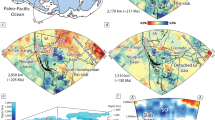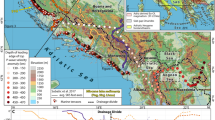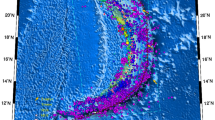Abstract
The spectacularly curved Banda arc comprises young oceanic crust1,2 enclosed by a volcanic inner arc, outer arc islands and a trough parallel to the Australian continental margin3,4,5. Strong seismic activity in the upper mantle defines a folded surface6,7, for which there are two contrasting explanations: deformation of a single slab5,8 or two separate slabs subducting from the north and south6,9. Here we combine seismic tomography with the plate tectonic evolution of the region to infer that the Banda arc results from subduction of a single slab. Our palaeogeographic reconstruction shows that a Jurassic embayment, which consisted of dense oceanic lithosphere enclosed by continental crust, once existed within the Australian plate. Banda subduction began about 15 million years ago when active Java subduction tore eastwards into the embayment. The present morphology of the subducting slab is only partially controlled by the shape of the embayment. As the Australian plate moved northward at a high speed of about 7 cm yr−1, the Banda oceanic slab rolled back towards the south–southeast accompanied by active delamination separating the crust from the denser mantle. Increasing resistance of the mantle to plate motion progressively folded the slab and caused strong deformation of the crust. The Banda arc represents an outstanding example of large-scale deformation of the Earth’s crust in response to coupling between the crust, slab and surrounding mantle.
This is a preview of subscription content, access via your institution
Access options
Subscribe to this journal
Receive 12 print issues and online access
$259.00 per year
only $21.58 per issue
Buy this article
- Purchase on Springer Link
- Instant access to full article PDF
Prices may be subject to local taxes which are calculated during checkout



Similar content being viewed by others
References
Hinschberger, F. et al. Magnetic lineations constraints for the back-arc opening of the late Neogene South Banda Basin (eastern Indonesia). Tectonophysics 333, 47–59 (2001).
Hinschberger, F. et al. Origine et évolution du bassin Nord-Banda (Indonésie): Apport des données magnetiques. C. R. Acad. Sci., Paris 331, 507–514 (2000).
Carter, D. J., Audley-Charles, M. G. & Barber, A. J. Stratigraphical analysis of island arc-continental margin collision in eastern Indonesia. J. Geol. Soc. Lond. 132, 179–189 (1976).
Bowin, C. et al. Arc-continent collision in the Banda Sea region. Am. Assoc. Petrol. Geol. Bull. 64, 868–918 (1980).
Hamilton, W. Tectonics of the Indonesian Region Vol. 1078 (US Geol. Soc. Prof. Pap., 1979).
Cardwell, R. K. & Isacks, B. L. Geometry of the subducted lithosphere beneath the Banda Sea in eastern Indonesia from seismicity and fault plane solutions. J. Geophys. Res. 83, 2825–2838 (1978).
Das, S. Seismicity gaps and the shape of the seismic zone in the Banda Sea region from relocated hypocentres. J. Geophys. Res. 109, B12303 (2004).
Hall, R. Cenozoic geological and plate tectonic evolution of SE Asia and the SW Pacific: Computer-based reconstructions, model and animations. J. Asian Earth Sci. 20, 353–434 (2002).
McCaffrey, R. Seismological constraints and speculations on Banda arc tectonics. Neth. J. Sea Res. 24, 141–152 (1989).
Hall, R. & Wilson, M. E. J. Neogene sutures in eastern Indonesia. J. Asian Earth Sci. 18, 787–814 (2000).
Hinschberger, F. et al. Late Cenozoic geodynamic evolution of eastern Indonesia. Tectonophysics 404, 91–118 (2005).
Bock, Y. et al. Crustal motion in Indonesia from Global Positioning System measurements. J. Geophys. Res. 108, 2367 (2003).
Stevens, C. W. et al. in Plate Boundary Zones (eds Stein, S. & Freymeuller, J. T.) 87–99 (Geodynamic Series, Vol. 30, American Geophysical Union, 2002).
Audley-Charles, M. G., Carter, D. J. & Milsom, J. Tectonic development of eastern Indonesia in relation to Gondwanaland dispersal. Nature 239, 35–39 (1972).
Charlton, T. R. Tertiary evolution of the Eastern Indonesia collision complex. J. Asian Earth Sci. 18, 603–631 (2000).
Widyantoro, S. & van der Hilst, R. V. Mantle structure beneath Indonesia inferred from high-resolution tomographic imaging. Geophys. J. Int. 130, 167–182 (1997).
Smyth, H. R., Hall, R. & Nichols, G. J. in Formation and Applications of the Sedimentary Record in Arc Collision Zones Vol. 436 (eds Draut A. E., et al.) 199–222 (Geol. Soc. Am. Spec. Pap., 2008).
Abbott, M. J. & Chamalaun, F. H. in The Geology and Tectonics of Eastern Indonesia Vol. 2 (eds Barber, A. J. & Wiryosujono S.) 253–268 Special Publication (Geol. Res. Dev. Centre Spec. Publ., 1981).
Macpherson, C. G. & Hall, R. in The Timing and Location of Major Ore Deposits in an Evolving Orogen Vol. 204 (eds Blundell D. J. et al.) 49–67 (Geol. Soc. Lond. Spec. Publ., 2002).
Audley-Charles, M. G., Carter, D. J., Barber, A. J., Norvick, M. S. & Tjokrosapoetro, S. Reinterpretation of the geology of Seram: Implications for the Banda Arc and northern Australia. J. Geol. Soc. Lond. 136, 547–568 (1979).
Norvick, M. S. The tectonic history of the Banda Arcs, eastern Indonesia: A review. J. Geol. Soc. Lond. 136, 519–527 (1979).
Pigram, C. J. & Panggabean, H. Rifting of the northern margin of the Australian continent and the origin of some microcontinents in eastern Indonesia. Tectonophysics 107, 331–353 (1984).
Fullerton, L. G., Sager, W. W. & Handschumacher, D. W. Late Jurassic–early Cretaceous evolution of the eastern Indian Ocean adjacent to northwest Australia. J. Geophys. Res. 94, 2937–2954 (1989).
Powell, C. M., Roots, S. R. & Veevers, J. J. Pre-breakup continental extension in East Gondwanaland and the early opening of the eastern Indian Ocean. Tectonophysics 155, 261–283 (1988).
Hall, R., Clements, B. & Smyth, H. R. Proc. Indonesian Petroleum Association, 33rd Annual Convention IPA09-G-134 (Indonesian Petrol. Assoc., 2009).
Müller, R., Royer, J-Y. & Lawver, L. A. Revised plate motions relative to the hotspots from combined Atlantic and Indian Ocean hotspot tracks. Geology 21, 275–278 (1993).
Sandiford, M. Seismic moment release during slab rupture beneath the Banda Sea. Geophys. J. Int. 174, 659–671 (2008).
Pairault, A. A., Hall, R. & Elders, C. F. Structural styles and tectonic evolution of the Seram Trough, Indonesia. Mar. Petrol. Geol. 20, 1141–1160 (2003).
Bijwaard, H. & Spakman, W. Nonlinear global P-wave tomography by iterated linearized inversion. Geophys. J. Int. 141, 71–82 (2000).
Kennett, B. L. N., Engdahl, E. R. & Buland, R. Constraints on seismic velocities in the Earth from traveltimes. Geophys. J. Int. 122, 108–124 (1995).
Acknowledgements
Part of this work (W.S.) was conducted under the programme of the Netherlands Research Centre of Integrated Solid Earth Sciences (ISES). This paper contributes to the ESG EUROCORES programme TOPO-EUROPE. R.H. is supported by the Royal Holloway SE Asia Research Group, which has been funded over many years by a consortium of oil companies.
Author information
Authors and Affiliations
Contributions
R.H. was responsible for tectonic reconstructions. W.S. was responsible for tomography and global positioning system analysis. Both authors contributed equally to development of ideas, interpretation and production of figures and manuscript.
Corresponding authors
Ethics declarations
Competing interests
The authors declare no competing financial interests.
Supplementary information
Supplementary Information
Supplementary Information (PDF 1285 kb)
Supplementary Movies
Supplementary Movie 1 (MOV 4859 kb)
Supplementary Movies
Supplementary Movie 2 (MOV 6926 kb)
Supplementary Movies
Supplementary Movie 3 (MOV 1154 kb)
Rights and permissions
About this article
Cite this article
Spakman, W., Hall, R. Surface deformation and slab–mantle interaction during Banda arc subduction rollback. Nature Geosci 3, 562–566 (2010). https://doi.org/10.1038/ngeo917
Received:
Accepted:
Published:
Issue Date:
DOI: https://doi.org/10.1038/ngeo917
This article is cited by
-
Aftershock study of the 2019 Ambon earthquake using moment tensor inversion: identification of fault reactivation in northern Banda, Indonesia
Earth, Planets and Space (2023)
-
East Asian analogues for early Alpine orogenesis
Swiss Journal of Geosciences (2023)
-
The ephemeral history of Earth’s youngest supra-subduction zone type ophiolite from Timor
Communications Earth & Environment (2023)
-
Tools for Edge Detection of Gravity Data: Comparison and Application to Tectonic Boundary Mapping in the Molucca Sea
Surveys in Geophysics (2023)
-
Genome editing reveals fitness effects of a gene for sexual dichromatism in Sulawesian fishes
Nature Communications (2021)



